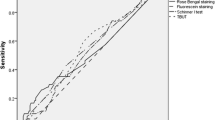Abstract
Objective
The aim of this study was to evaluate the tear clearance in patients with dry eye syndrome using quantitative lacrimal scintigraphy.
aterials and Methods
We investigated 21 patients (42 eyes; 18 women, 3 men; mean age, 63.19 ± 13.33 years) with dry eye syndrome. Additionally, for the sake of comparison, 12 normal subjects of the same age group (24 eyes; 10 women, 2 men; mean age, 68.25 ± 2.63 years) were included. Lacrimal scintigraphy, Schirmer-1 test, BUT, and rose bengal ocular surface vital staining were performed in these cases.
Results
ccording to the results of lacrimal scintigraphy, the mean value of Tl/2 was 4.16 ± 1.22 minutes and the mean value of RI was 14.15% ± 2.30% in normal subjects. However, in patients with dry eye syndrome, these values were 20.59 ± 1.97 minutes and 55.64% ± 6.90%, respectively. Consistent with the results of Ophthalmologic tests, the mean Schirmer-1 value was 12.46 ± 2.10 mm, the mean value of BUT was 14.36 ± 3.40 seconds, and the mean staining value of the rose bengal was 1.98 ± 0.80 in normal subjects, whereas these values were 1.36 ± 0.49 mm, 5.46 ± 1.33 seconds, 6.62 ± 0.86, respectively, in patients with dry eye syndrome. When we compared the results of lacrimal scintigraphy and the results of Ophthalmologic tests, an inverse correlation was noted between both the Tl/2 and RI values and both the Schirmer-1 and BUT values in all subjects (p < 0.001). However, there was a greater positive correlation between the rose bengal ocular surface staining value and both the Tl/2 and RI values in all cases (p < 0.001).
Conclusion
In the current study, it was concluded that although the lacrimal drainage system was normal, tear clearance was significantly delayed in dry eye patients. With this study, we have shown that quantitative lacrimal scintigraphy, which is an objective, practical, and noninvasive method, appears to be useful for the assessment of the tear clearance in patients with dry eye syndrome.
Similar content being viewed by others
References
Dursun D, Wang M, Monroy D, Li D, Lokeshwar BL, Stern ME, et al. A mouse model of keratoconjunctivitis sicca.IOVS 2002; 43 (3): 632–638.
Tsubota K. Tear dynamics and dry eye.Retinal and Eye Research 1998; 17 (4): 565–596.
Terry MA. Dry eye in the elderly.Drugs and Aging 2001; 18(2): 101–107.
Pflugfelder SC, Solomon A, Stern ME. The diagnosis and management of dry eye.Cornea 2000; 19 (5): 644–649.
Pflugfelder SC, Tseng SC, Sanabria O, Kell H, Garcia CG, Felix C, et al. Evaluation of subjective assessments and objective diagnostic tests for diagnosing film disorders known to cause ocular irritation.Cornea 1998; 17: 38–56.
Gilbard JP, Farris RL, Santamaria IJ. Osmolarity of tear microvolumes in keratoconjunctivitis sicca.Arch Ophthalmol 1978; 96: 677–681.
McCollum CJ. Rapid assay of lactoferrin in keratoconjunctivitis sicca.Cornea 1994; 13: 505–508.
Danjo Y Ocular surface damage and tear lactoferrin in dry-eye syndrome.Acta Ophthalmol 1994; 72: 433–437.
Yen MT, Pflugfelder SC, Feuer WJ. The effect of punctal occlusion on tear production, tear clearance, and ocular surface sensation in normal subjects.Am J Ophthalmol 2001; 131:314–323.
Prabhasawat P, Tseng SCG. Frequent association of delayed tear clearance in ocular irritation.Br J Ophthalmol 1998; 82: 666–675.
Alfonso A, Monroy D, Stern ME, Feuer WJ, Tseng SCG, Pflugfelder SC. Correlation of tear fluorescein clearance and Schirmer test scores with ocular irritation symptoms.Ophthalmol 1999; 106 (4): 803–810.
Macri A, Ronaldo M, Pflugfelder S. A standardized visual scale for evaluation of tear fluorescein clearance.Ophthalmol 2000; 107 (7): 1338–1343.
Hurwitz JJ, Kirsch J. Nuclear lacrimal scanning. In:The Lacrimal system, Hurwitz JJ (ed), Philadelphia; Lippincott-Raven, 1996: 73–81.
Kersten RC, Bartley GB. Evalution and management of the tearing patients.Basic and Clinical Science Course 1999-2000;7:231–255.
Amanat LA, Hildrict TE. Lacrimal scintigraphy: II. Its role in the diagnosis of epiphora.Br J Ophthalmol 1983; 67: 720–728.
Dursun D, Ertan A, Bilezikci B, Akova YA, Pelit A. Ocular surface changes in keratoconjunctivitis sicca with silicone punctum plug occlusion.Current Eye Research 2003; 26: 263–269.
Van Bijsterveld OP. Diagnostic tests in sicca syndrome.Arch Ophthalmol 1969; 82: 10–14.
O’Rourke J. Measurement of anterior chamber dynamic functions. In:Nuclear ophthalmology dynamic function studies in intraocular disease, Philadelphia; WB Saunders Company, 1976: 23–50.
de Paiva CS, Pflugfelder SC. Tear clearance implications for ocular surface health.Exp Eye Res 2004; 78: 395–397.
Heyman S, Katowitz JA. Dacryoscintigraphy. In:Pediatric Nuclear Medicine (2nd ed), Treves ST (ed),New York; Springer-Verlag, 1995: 121–134.
Greaves JL, Wilson CG, Galloway NR, Birmingham AT, Olejnik O. A comparison of the precorneal residence of an artificial tear preparation in patients with keratoconjunctivitis sicca and normal volunteer subjects using gamma scintigraphy.Acta Ophthal 1991; 69: 432–436.
Zhu Y, Wilson CG, Meadows D, Olejnik O, Frier M, Washington N, et al. Dry powder dosing in liquid vehicles: ocular tolerance and scintigraphic evaluation of a perfluorocarbon suspension.Int J Pharm 1999; 191 (2): 79–85.
Wilson CG, Zhu YP, Frier M, Rao LS, Gilchrist P, Perkins AC. Ocular contact time of a carbomer gel (GelTears) in humans.Br J Ophthalmol 1998; 82 (10): 1131–1134.
Snibson GR, Greaves JL, Soper ND, Prydal JI, Wilson CG, Bron AJ. Precorneal residence times of sodium hyaluronate solutions studied by quantitative gamma scintigraphy.Eye 1990; 4: 594–602.
Sorbara L, Simpson T, Vaccari S, Jones L, Fonn D. Tear turnover rate is reduced in patients with symptomatic dry eye.Contact Lens Anterior Eye 2004; 27: 15–20.
Tsubota K, Kaido M, Yagi Y, Fujihara T, Shimmura S. Diseases associated with ocular surface abnormalities: the importance of reflex tearing.Br J Ophthalmol 1999; 83: 89–91.
Pflugfelder SC, Solomon A, Dursun D, Li D. Dry eye and delayed tear clearance: “A call to arms.”Adv Exper Med Biol 2002; 506: 739–743.
Author information
Authors and Affiliations
Corresponding author
Rights and permissions
About this article
Cite this article
Gencoglu, E.A., Dursun, D., Akova, Y.A. et al. Tear clearance measurement in patients with dry eye syndrome using quantitative lacrimal scintigraphy. Ann Nucl Med 19, 581–587 (2005). https://doi.org/10.1007/BF02985051
Received:
Accepted:
Issue Date:
DOI: https://doi.org/10.1007/BF02985051




